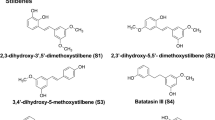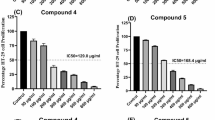Abstract
We have previously shown that the two sesquiterpene lactones, salograviolide A (Sal A) and iso-seco-tanapartholide (TNP), isolated from the Middle Eastern indigenous plants Centaurea ainetensis and Achillea falcata, respectively, possess selective antitumor properties. Here, we aimed to assess the anticancer effects of the separate compounds and their combination, study their potential to generate reactive oxygen species (ROS), and investigate their underlying antitumor mechanisms in human colon cancer cell lines. Cells were treated with Sal A and TNP alone or in combination, and cell viability, cell cycle profile, apoptosis, ROS generation and changes in protein expression were monitored. Sal A and TNP in combination caused 80 % decrease in HCT-116 and DLD-1 cell viability versus only 25 % reduction when the drugs were used separately. The antitumor mechanism involved triggering ROS-dependent apoptosis as well as disruption of the mitochondrial membrane potential. Further studies showed that apoptosis by the Sal A and TNP combination was caspase-independent and that ERK, JNK and p38 of the serine/threonine MAPKs signaling pathway were involved in the cell death mechanism. Taken together, our data suggest that the combination of Sal A and TNP may be of therapeutic interest against colon cancer.





Similar content being viewed by others
Abbreviations
- Bax:
-
Bcl-2-associated X protein
- Bcl-2:
-
B cell lymphoma 2
- DTT:
-
Dithiothreitol
- ERK:
-
Extracellular signal-related kinase
- JNK:
-
c-Jun-NH2-terminal kinase
- MAPK:
-
Mitogen activated protein kinase
- NAC:
-
N-Acetyl cysteine
- NF-κB:
-
Nuclear factor-kappaB
- PI:
-
Propidium iodide
- ROS:
-
Reactive oxygen species
- SL:
-
Sesquiterpene lactone
References
Azaizeh H, Saad B, Cooper E, Said O (2008) Traditional Arabic and Islamic medicine, a reemerging health aid. Evid Based Complement Alternat Med 7(4):419–424
Fakhoury I, Gali-Muhtasib H (2011) Salograviolide A: a plant-derived sesquiterpene lactone with promising anti-inflammatory and anticancer effects. In: Gali-Muhtasib Hala (ed) Advances in cancer therapy. InTech Publishing Group, Croatia, pp 369–388
Kaufman PB, Cseke LJ, Warber S, Duke JA, Brielmann HL (1998) Natural products from plants, 1st edn. CRC Press, New York
Ghantous A, Gali-Muhtasib H, Vuorela H, Saliba N, Darwiche N (2010) What made sesquiterpene lactones reach cancer clinical trials? Drug Discov Today 15:668–678
Berger TG, Dieckmann D, Efferth T, Schultz ES, Funk JO, Baur A, Schuler G (2005) Artesunate in the treatment of metastatic uveal melanoma-first experiences. Oncol Rep 14:1599–1603
Christensen SB, Skytte DM, Denmeade SR, Dionne C, Moller JV, Nissen P, Isaacs JT (2009) A Trojan horse in drug development: targeting of thapsigargins towards prostate cancer cells. Anticancer Agents Med Chem 9:276–294
Efferth T (2007) Willmar Schwabe award 2006: antiplasmodial and antitumor activity of artemisinin—from bench to bedside. Planta Med 73:299–309
Guzman ML, Rossi RM, Neelakantan S, Li X, Corbett CA, Hassane DC, Becker MW, Bennett JM, Sullivan E, Lachowicz JL, Vaughan A, Sweeney CJ, Matthews W, Carroll M, Liesveld JL, Crooks PA, Jordan CT (2007) An orally bioavailable parthenolide analog selectively eradicates acute myelogenous leukemia stem and progenitor cells. Blood 110:4427–44359
Pan MH, Chiou YS, Cheng AC, Bai N, Lo CY, Tan D, Ho CT (2007) Involvement of MAPK, Bcl-2 family, cytochrome c, and caspases in induction of apoptosis by 1,6-O,O-diacetylbritannilactone in human leukemia cells. Mol Nutr Food Res 51:229–238
Saliba N, Dakdouki S, Homeidan FR, Kogan J, Bouhadir K, Talhouk SN, Talhouk R (2009) Bio-guided identification of an anti-inflammatory guaianolide from Centaurea ainetensis. Pharm Biol 47:701–707
Ghantous A, Nasser N, Saab I, Darwiche N, Saliba N (2009) Structure-activity relationship of seco-tanapartholides isolated from Achillea falcata for inhibition of HaCaT cell growth. Eur J Med Chem 44:3794–3797
Daniewski WM, Nowak G, Routsi E, Rychlewska U, Szczepanska B, Skibicki P (1992) Salograviolide A, a sesquiterpene from Centaurea salonitana. Phytochemistry 31:2891–2893
Vajs V, Todorovic N, Ristic M, Tesevic V, Todorovic B, Janackovic P, Marin P, Milosavljevic S (1999) Guaianolides from Centaurea nicolai: antifungal activity. Phytochemistry 52:383–386
Barbour EK, Al Sharif M, Sagherian VK, Habre AN, Talhouk R, Talhouk SN (2004) Screening of selected indigenous plants of Lebanon for antimicrobial activity. J Ethnopharmacol 93:1–7
Al-Saghir J, Al-Ashi R, Salloum R, Saliba N, Talhouk R, Homaidan FR (2009) Anti-inflammatory properties of salograviolide A purified from Lebanese plant Centaurea ainetensis. BMC Complement Altern Med 9:36
Ghantous A, Abou Tayyoun A, Abou Lteif G, Saliba N, Gali-Muhtasib H, El-Sabban M, Darwiche N (2008) Purified salograviolide A isolated from Centaurea ainetensis causes growth inhibition and apoptosis in neoplastic epidermal cells. Int J Oncol 32:841–849
El-Najjar N, Dakdouki S, Darwiche N, El-Sabban M, Saliba N, Gali-Muhtasib H (2008) Anti-colon cancer effects of salograviolide A isolated from Centaurea ainetensis. Oncol Rep 19:897–904
Luna-Herrera J, Costa MC, Gonzalez HG, Rodrigues AI, Castillo PC (2007) Synergistic antimycobacterial activities of sesquiterpene lactones from Laurus spp. JAC 59:548–552
Verschoor ML, Wilson LA, Singh G (2010) Mechanisms associated with mitochondrial-generated reactive oxygen species in cancer. Can J Physiol Pharmacol 88:204–219
Cory S, Huang DC, Adams JM (2003) The Bcl-2 family: roles in cell survival and oncogenesis. Oncogene 22:8590–8607
Zhang S, Won YK, Ong CN, Shen HM (2005) Anti-cancer potential of sesquiterpene lactones: bioactivity and molecular mechanisms. Curr Med Chem Anticancer Agents 5:239–249
Fiers W, Beyaert R, Declercq W, Vandenabeele P (1999) More than one way to die: apoptosis necrosis and reactive oxygen damage. Oncogene 18:7719–7730
Itani W, El-Banna SH, Hassan SB, Larsson RL, Bazarbachi A, Gali-Muhtasib H (2008) Anti colon cancer components from Lebanese sage (Salvia libanotica) essential oil. Cancer Biol Ther 7:1765–1773
Darwiche N, El-Banna S, Gali-Muhtasib H (2007) Cell cycle modulatory and apoptotic effects of plant-derived anticancer drugs in clinical use or development. Expert Opin Drug Discov 2:361–379
Zhang S, Ong CN, Shen HM (2004) Critical roles of intracellular thiols and calcium in parthenolide-induced apoptosis in human colorectal cancer cells. Cancer Lett 208:143–153
Hadzic T, Aykin-Burns N, Zhu Y, Coleman MC, Leick K, Jacobson GM, Spitz DR (2010) Paclitaxel combined with inhibitors of glucose and hydroperoxide metabolism enhances breast cancer cell killing via H2O2-mediated oxidative stress. Free Radic Biol Med 48:1024–1033
Schmidt TJ, LyB G, Pahl HL, Merfortb I (1999) Helenanolide type sesquiterpene lactones, Part 5: the role of glutathione addition under physiological conditions. Bioorg Med Chem 7:2849–2855
Kaufmann SH, Earnshow WC (2000) Induction of apoptosis by cancer chemotherapy. Exp Cell Res 256:42–49
Dirsh VM, Stuppner H, Vollmar AM (2001) Helenalin triggers a CD95 death receptor-independent apoptosis that is not affected by overexpression of Bcl-x(L) or Bcl-2. Cancer Lett 61:5817–5823
Lee MG, Lee KT, Chi SG, Park JH (2001) Costunolide induces apoptosis by ROS-mediated mitochondrial permeability transition and cytochrome C release. Biol Pharm Bull 24:303–306
Benhar M, Engelberg D, Levitski A (2002) ROS, stress-activated kinases and stress signaling in cancer. EMBO Rep 3:420–425
Zhang S, Lin ZN, Yang CF, Shi X, Ong CN, Shen HM (2005) Suppressed NF-kappaB and sustained JNK activation contribute to the sensitization effect of parthenolide to TNF-alpha-induced apoptosis in human cancer cells. Carcinogenesis 25:2191–2199
Cho BJ, Im EK, Kwon JH, Lee KH, Shin HJ, Oh J, Kang SM, Chung JH, Jang Y (2005) Berberine inhibits the production of lysophosphatidylcholine-induced reactive oxygen species and the ERK1/2 pathway in vascular smooth muscle cells. Mol Cells 20:429–434
Guyton KZ, Liu Y, Gorospe M, Xu Q, Holbrook NJ (1996) Activation of mitogen-activated protein kinase by H2O2: role in cell survival following oxidant injury. J Biol Chem 271:4138–4142
Kamata H, Honda S, Maeda S, Chang L, Hirata H, Karin M (2005) Reactive oxygen species promote TNFα-induced death and sustained JNK activation by inhibiting MAP kinase phosphatases. Cell 120:649–661
Lotem J, Kama R, Sachs L (1999) Suppression or induction of apoptosis by opposing pathways downstream from calcium-activated calcineurin. Proc Natl Acad Sci USA 96:12016–12020
Acknowledgments
This work was supported by grants from UNISANTIS and the research was conducted under the direction of the Nature Conservation Center for Sustainable Futures (Ibsar) at the American University of Beirut, Lebanon. We would like to thank members of the Central Research Science Laboratory at the American University of Beirut, Lebanon for their technical assistance with the use of the flow cytometer.
Conflict of interest
The authors declare that they have no competing financial interests.
Author information
Authors and Affiliations
Corresponding author
Additional information
M. Salla and I. Fakhoury contributed equally
Rights and permissions
About this article
Cite this article
Salla, M., Fakhoury, I., Saliba, N. et al. Synergistic anticancer activities of the plant-derived sesquiterpene lactones salograviolide A and iso-seco-tanapartholide. J Nat Med 67, 468–479 (2013). https://doi.org/10.1007/s11418-012-0703-6
Received:
Accepted:
Published:
Issue Date:
DOI: https://doi.org/10.1007/s11418-012-0703-6




